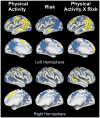Interactive effects of physical activity and APOE-ε4 on BOLD semantic memory activation in healthy elders
- PMID: 20691792
- PMCID: PMC2962671
- DOI: 10.1016/j.neuroimage.2010.07.070
Interactive effects of physical activity and APOE-ε4 on BOLD semantic memory activation in healthy elders
Abstract
Evidence suggests that physical activity (PA) is associated with the maintenance of cognitive function across the lifespan. In contrast, the apolipoproteinE-ε4 (APOE-ε4) allele, a genetic risk factor for Alzheimer's disease (AD), is associated with impaired cognitive function. The objective of this study was to examine the interactive effects of PA and APOE-ε4 on brain activation during memory processing in older (ages 65-85) cognitively intact adults. A cross-sectional design was used with four groups (n=17 each): (1) Low Risk/Low PA; (2) Low Risk/High PA; (3) High Risk/Low PA; and (4) High Risk/High PA. PA level was based on self-reported frequency and intensity. AD risk was based on presence or absence of an APOE-ε4 allele. Brain activation was measured using event-related functional magnetic resonance imaging (fMRI) while participants performed a famous name discrimination task. Brain activation subserving semantic memory processing occurred in 15 functional regions of interest. High PA and High Risk were associated with significantly greater semantic memory activation (famous>unfamiliar) in 6 and 3 of the 15 regions, respectively. Significant interactions of PA and Risk were evident in 9 of 15 brain regions, with the High PA/High Risk group demonstrating greater semantic memory activation than the remaining three groups. These findings suggest that PA selectively increases memory-related brain activation in cognitively intact but genetically at-risk elders. Longitudinal studies are required to determine whether increased semantic memory processing in physically active at-risk individuals is protective against future cognitive decline.
Copyright © 2010 Elsevier Inc. All rights reserved.
Figures



Similar articles
-
Interactive effects of physical activity and APOE-ε4 on white matter tract diffusivity in healthy elders.Neuroimage. 2016 May 1;131:102-12. doi: 10.1016/j.neuroimage.2015.08.007. Epub 2015 Aug 8. Neuroimage. 2016. PMID: 26265157 Free PMC article.
-
Genetic risk for Alzheimer's disease alters the five-year trajectory of semantic memory activation in cognitively intact elders.Neuroimage. 2015 May 1;111:136-46. doi: 10.1016/j.neuroimage.2015.02.011. Epub 2015 Feb 14. Neuroimage. 2015. PMID: 25687593 Free PMC article.
-
Semantic memory activation in amnestic mild cognitive impairment.Brain. 2009 Aug;132(Pt 8):2068-78. doi: 10.1093/brain/awp157. Epub 2009 Jun 10. Brain. 2009. PMID: 19515831 Free PMC article.
-
How does apolipoprotein E genotype influence the relationship between physical activity and Alzheimer's disease risk? A novel integrative model.Alzheimers Res Ther. 2023 Jan 27;15(1):22. doi: 10.1186/s13195-023-01170-4. Alzheimers Res Ther. 2023. PMID: 36707869 Free PMC article. Review.
-
Apolipoprotein E (APOE) ε4 and episodic memory decline in Alzheimer's disease: A review.Ageing Res Rev. 2016 May;27:15-22. doi: 10.1016/j.arr.2016.02.002. Epub 2016 Feb 11. Ageing Res Rev. 2016. PMID: 26876367 Free PMC article. Review.
Cited by
-
The relationship between physical activity, apolipoprotein E ε4 carriage, and brain health.Alzheimers Res Ther. 2020 Apr 24;12(1):48. doi: 10.1186/s13195-020-00608-3. Alzheimers Res Ther. 2020. PMID: 32331531 Free PMC article.
-
A review of cardiorespiratory fitness-related neuroplasticity in the aging brain.Front Aging Neurosci. 2013 Jul 12;5:31. doi: 10.3389/fnagi.2013.00031. eCollection 2013. Front Aging Neurosci. 2013. PMID: 23874299 Free PMC article.
-
The Utility of Cerebrovascular Reactivity MRI in Brain Rehabilitation: A Mechanistic Perspective.Front Physiol. 2021 Mar 17;12:642850. doi: 10.3389/fphys.2021.642850. eCollection 2021. Front Physiol. 2021. PMID: 33815146 Free PMC article. Review.
-
The effect of physical activity on white matter integrity in aging and prodromal to mild Alzheimer's disease with vascular comorbidity.Front Aging Neurosci. 2023 Jun 21;15:1096798. doi: 10.3389/fnagi.2023.1096798. eCollection 2023. Front Aging Neurosci. 2023. PMID: 37520122 Free PMC article.
-
Physical activity and beta-amyloid pathology in Alzheimer's disease: A sound mind in a sound body.EXCLI J. 2017 Jun 28;16:959-972. doi: 10.17179/excli2017-475. eCollection 2017. EXCLI J. 2017. PMID: 28900376 Free PMC article. Review.
References
-
- Ang ET, Gomez-Pinilla F. Potential therapeutic effects of exercise to the brain. Curr Med Chem. 2007;14:2564–2571. - PubMed
-
- Ashburner J, Friston KJ. Unified segmentation. Neuroimage. 2005;26:839–851. - PubMed
-
- Ben J, Soares FM, Cechetti F, Vuaden FC, Bonan CD, Netto CA, Wyse AT. Exercise effects on activities of Na(+),K(+)-ATPase, acetylcholinesterase and adenine nucleotides hydrolysis in ovariectomized rats. Brain Res. 2009;1302:248–255. - PubMed
-
- Bernstein MS, Costanza MC, James RW, Morris MA, Cambien F, Raoux S, Morabia A. Physical activity may modulate effects of ApoE genotype on lipid profile. Arterioscler Thromb Vasc Biol. 2002;22:133–140. - PubMed
Publication types
MeSH terms
Substances
Grants and funding
LinkOut - more resources
Full Text Sources
Medical
Miscellaneous

